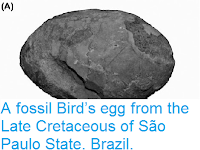The Bohaiornithids were an early group of Enantiornithine Birds (a group of Toothed Birds dominant in many Cretaceous faunas; the modern Euornithine Birds having come to prominence only after the End Cretaceous Extinction). The Bohaiornithids are known from the Jiufotang and Yixian Formations, together the Jehol Biota, giving them a chronological range from 125 to 120 million years ago.
In a paper published in the journal Palaeontology on 13 November 2016, Jennifer Peteya of the Department of Biology and Integrated Bioscience Program at the University of Akron, Julia Clarke of the Department of Geological Sciences at the University of Texas at Austin, Quangou Li of the State Key Laboratory of Biogeology and Environmental Geology at the China University of Geosciences, Ke-Qin Gao of the School of Earth and Space Sciences at Peking University and Matthew Shawkey, also of the Department of Biology and Integrated Bioscience Program at the University of Akron and of the Terrestrial Ecology Unit at the University of Ghent describe a new Bohaiornithid specimen with well preserved plumage from the Early Cretaceous Jiufotang Formation of Liaoning Province in northeastern China.
The new specimen is adjudged to be a subadult based upon the development of its skeleton. It does not appear to be a member of any previously described species of Bohaiornithid, but since the ontogeny (development) of these Birds is not well understood, Peteya et al. refrain from describing it as a member of a new species. However despite lacking a fully mature skeleton, the specimen appears to have full adult plumage; this is different to the situation in modern Birds, which do not gain their full adult plumage, or ability to fly, until they are fully mature.
Ventral view of the new Bohaiornithid specimen. (A) Photograph of the primary slab. (B) Interpretive drawing. Abbreviations: co, coracoid; cv, cervical vertebrae; fe, femur; fu, furcula; hu, humerus; il, ilium; mcI–III, metacarpals I–III; mt, metatarsals; pd I–IV, pedal digits I–IV; phI-1, first phalanx of digit I; phII/III-1/2, first/second phalanx of digit II/III; pu, pubis; py, pygostyle; ra, radius; sc, scapula; sk, skull; sml, semilunate carpal; st, sternum; sy, synsacrum; th, thoracic vertebrae; ti, tibia; ul, ulna; uln, ulnare. Scale bar represents 1 cm. Peteya et al. (2016).
Close examination of the plumage of the specimen revealed the presence of preserved melanosomes (pigment bearing-cells). When these cells were analysed using Raman spectroscopy, suggested that three different types of melanosomes were present, associated with black, brown and iridescent colouring. While it was not possible to tell the colour of the iridescent plumage was impossible to tell, but the presence of iridescent colouring in a Bird that was not fully grown is interesting. In modern Birds the presence of iridescent plumage is always associated with sexual maturity, often coming some time after the Bird reaches physical maturity. If the iridescent feathers of the Jehol Bird are also associated with sexual maturity, then it implies that this Bird reached sexual maturity before it was fully grown. This is completely different from the situation seen in modern Birds, but is similar to that seen in their closest living relatives (and the only other surviving Archosaur group) the Crocodylians, in which sexual maturity is reached long before full size is achieved.
See also...
Follow Sciency Thoughts on Facebook.







